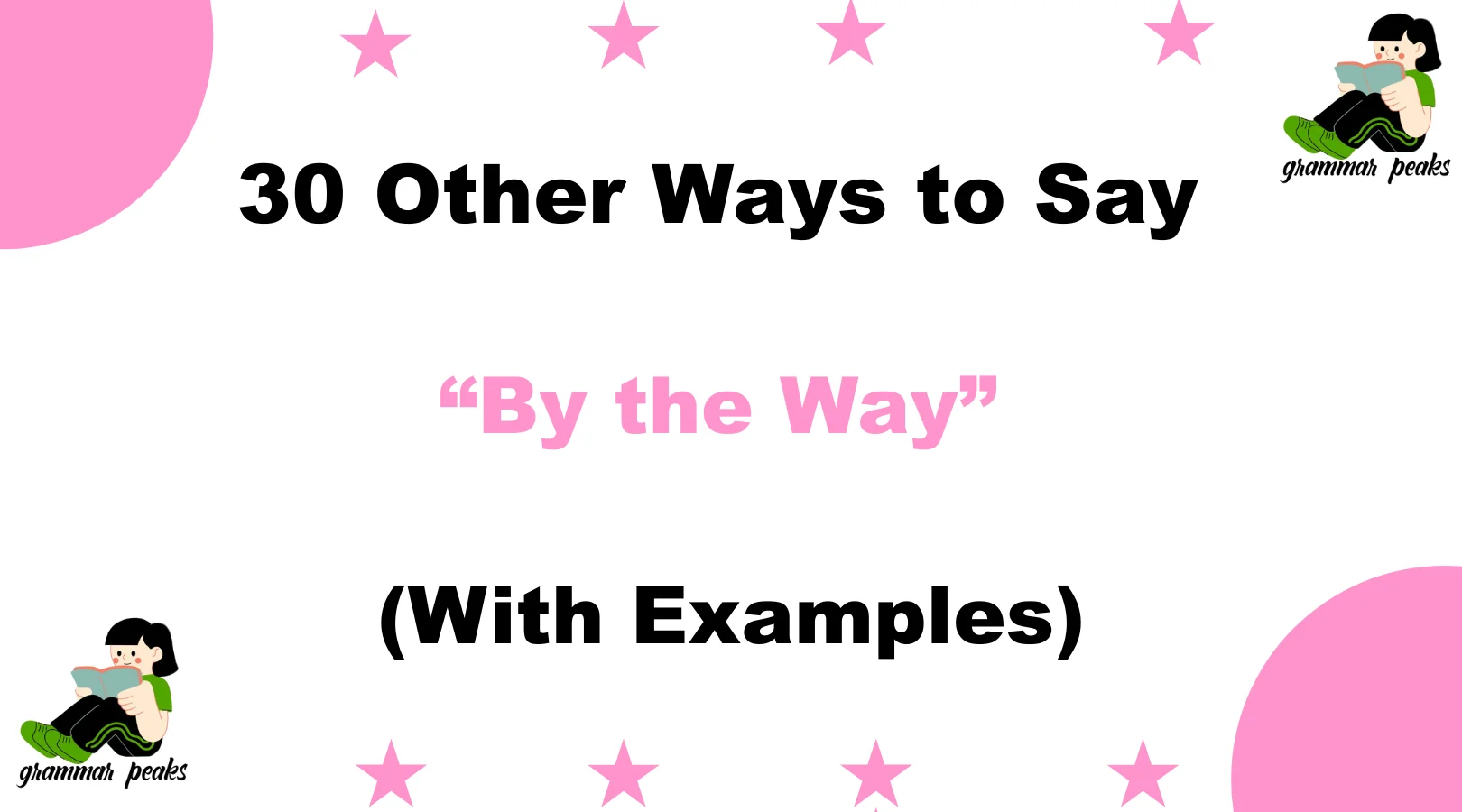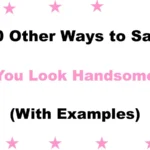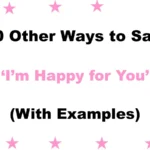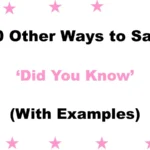In both casual and professional conversations, small transitions can carry a lot of weight. Phrases like “By the way” help introduce new information, reminders, or side notes without derailing the main topic. But repeating the same phrase over and over can feel stale or overly informal—especially in writing or meetings. This list gives you 30 better ways to say “By the Way” that sound fresh, natural, and suited for different tones and contexts.
What Does “By the Way” Mean?
“By the way” is a conversational phrase used to add extra information, often unrelated or slightly off-topic from the main conversation. It softens the interruption and makes transitions sound more natural or polite.
When to Use “By the Way”
Use it when you want to:
- Introduce a reminder or extra detail
- Mention something unrelated without sounding abrupt
- Shift the topic gently in conversation
- Bring up something that might have been forgotten
Is It Professional/Polite to Say “By the Way”?
Yes—but only in casual to semi-formal settings. In emails or meetings, “By the way” can sound slightly informal. In professional communication, consider using more polished alternatives like “As a side note,” “Additionally,” or “Just to add.”
Pros and Cons of Saying “By the Way”
Pros:
- Easy and conversational
- Helps with transitions
- Softens abrupt changes in topic
Cons:
- Too informal for some workplace settings
- Can seem offhanded or unimportant
- Overuse may dilute your point
Synonyms For “By the Way”
- Incidentally
- Just So You Know
- On That Note
- While We’re at It
- In Case You Didn’t Know
- Speaking of Which
- Before I Forget
- On a Different Note
- Additionally
- In Addition
- Moreover
- Also
- Another Thing
- Just a Heads-Up
- To Change the Subject Slightly
- As an Aside
- While I Remember
- Parenthetically
- On Another Note
- Just a Reminder
- Not to Mention
- Plus
- That Reminds Me
- Apropos
- Further to That
- Along Those Lines
- One More Thing
- Just to Add
- By the By
- In Passing
1. As a Side Note
Definition: Used to mention something additional or tangential.
Detailed Explanation: Perfect for adding context without shifting the conversation too abruptly.
Scenario Example: “As a side note, we’ll need to revise the deadline if the supplier delays shipment.”
Best Use: Business meetings, formal emails.
Worst Use: Text messages or casual chats—it may feel too stiff.
Tone: Polished, slightly formal.
2. Just So You Know
Definition: Informal way to introduce helpful or relevant information.
Detailed Explanation: Good for giving heads-up info that’s not critical but still worth mentioning.
Scenario Example: “Just so you know, the team already submitted that report.”
Best Use: Team chats, friendly reminders.
Worst Use: In professional reports or documents.
Tone: Casual, helpful.
3. For Your Information
Definition: A formal way to present extra facts or data.
Detailed Explanation: Often abbreviated as “FYI,” it’s useful in professional messages.
Scenario Example: “For your information, the client has already signed the agreement.”
Best Use: Internal emails, workplace updates.
Worst Use: Social conversations—it feels overly formal.
Tone: Informative, concise.
4. Incidentally
Definition: A smooth way to add something unrelated to the main point.
Detailed Explanation: Ideal for transitions in formal writing or speeches.
Scenario Example: “Incidentally, have you spoken with the new intern yet?”
Best Use: Presentations, formal discussions.
Worst Use: Everyday talk—it can sound a bit dated.
Tone: Formal, thoughtful.
5. While We’re on the Subject
Definition: A smooth segue when the additional point relates to the current topic.
Detailed Explanation: Keeps the flow natural while changing direction.
Scenario Example: “While we’re on the subject of deadlines, don’t forget the Q4 timeline.”
Best Use: Meetings or presentations.
Worst Use: When the side note is unrelated.
Tone: Conversational, relevant.
6. Speaking of Which
Definition: A conversational cue that links the current topic to a related point.
Detailed Explanation: Smoothly bridges one idea to another, showing the connection rather than an abrupt shift.
Scenario Example: “Speaking of which, have you scheduled the client presentation yet?”
Best Use: Team meetings or friendly business chats where topics naturally overlap.
Worst Use: Highly formal reports—it can feel too casual.
Tone: Warm, conversational.
7. Before I Forget
Definition: Signals an important side note you don’t want to overlook.
Detailed Explanation: Adds urgency to the information, implying it might slip your mind later.
Scenario Example: “Before I forget, payroll needs your new tax forms by Friday.”
Best Use: Quick reminders in email or casual conversation.
Worst Use: Formal documents—it sounds off-the-cuff.
Tone: Informal, attentive.
8. On a Different Note
Definition: Announces a clear change of subject.
Detailed Explanation: Creates a neat boundary between topics, helpful when the new point is unrelated.
Scenario Example: “On a different note, the cafeteria menu will change next month.”
Best Use: Agendas, meetings, or structured emails.
Worst Use: Rapid-fire chats where rigid transitions feel stiff.
Tone: Neutral, organized.
9. Additionally
Definition: Adds supplementary information that supports or extends the current point.
Detailed Explanation: More formal than “by the way”; ideal for professional writing.
Scenario Example: “Additionally, we’ll need final artwork by Tuesday.”
Best Use: Reports, proposals, and client communication.
Worst Use: Informal text messages—it sounds overly formal.
Tone: Formal, precise.
10. In Addition
Definition: Another formal phrase for including extra details.
Detailed Explanation: Works well when listing multiple points in sequence.
Scenario Example: “In addition, training sessions will be held every Monday.”
Best Use: Presentations, white papers.
Worst Use: Casual speech—it can feel stiff.
Tone: Professional, orderly.
11. Moreover
Definition: Introduces information that strengthens or intensifies the previous statement.
Detailed Explanation: Elevates the register of your writing; often used in persuasive contexts.
Scenario Example: “Moreover, early adopters reported a 20% productivity boost.”
Best Use: Formal reports, research papers.
Worst Use: Everyday chats—it sounds academic.
Tone: Formal, emphatic.
12. Also
Definition: A simple word for appending related information.
Detailed Explanation: Versatile and clear—works in almost any setting.
Scenario Example: “Also, don’t forget to submit your timesheets.”
Best Use: Emails, conversations, presentations—nearly universal.
Worst Use: None, though overuse can feel repetitive.
Tone: Neutral, straightforward.
13. Another Thing
Definition: Casual phrase to introduce an extra point or reminder.
Detailed Explanation: Adds a friendly tone but can sound informal if overused.
Scenario Example: “Another thing—parking passes expire next week.”
Best Use: Team huddles, informal emails.
Worst Use: Contracts or legal documents.
Tone: Casual, friendly.
14. Just a Heads-Up
Definition: Signals a helpful warning or preview.
Detailed Explanation: Implies the information could impact the listener soon.
Scenario Example: “Just a heads-up: IT will reboot servers tonight.”
Best Use: Service announcements, quick Slack notes.
Worst Use: Academic essays—it’s too colloquial.
Tone: Informal, helpful.
15. To Change the Subject Slightly
Definition: Clearly states you’re steering the conversation elsewhere.
Detailed Explanation: Softens a topic shift, showing you’re aware of the pivot.
Scenario Example: “To change the subject slightly, have we confirmed Friday’s agenda?”
Best Use: Live meetings or nuanced discussions.
Worst Use: Emails—it can feel wordy.
Tone: Polite, deliberate.
16. As an Aside
Definition: Introduces tangential or less-central information.
Detailed Explanation: Common in presentations to share supporting data.
Scenario Example: “As an aside, our competitor just launched a similar feature.”
Best Use: Formal talks, webinars, articles.
Worst Use: Rapid chats—might seem pretentious.
Tone: Semi-formal, reflective.
17. While I Remember
Definition: Similar to “before I forget,” used to preface a timely note.
Detailed Explanation: Conveys urgency while remaining conversational.
Scenario Example: “While I remember, please RSVP for the workshop.”
Best Use: Quick reminders in meetings or calls.
Worst Use: Written reports—it feels off-hand.
Tone: Casual, conscientious.
18. Parenthetically
Definition: Signals information inserted as a side remark.
Detailed Explanation: Literary and formal; best in writing rather than speech.
Scenario Example: “Parenthetically, market share rose 3% last quarter.”
Best Use: Academic or analytical documents.
Worst Use: Spoken conversation—it sounds unnatural.
Tone: Academic, precise.
19. On Another Note
Definition: Introduces a loosely related or new topic.
Detailed Explanation: Works well to pivot gracefully in emails or meetings.
Scenario Example: “On another note, the holiday schedule is now live.”
Best Use: Business correspondence, staff updates.
Worst Use: Very formal legal writing.
Tone: Neutral, smooth.
20. Just a Reminder
Definition: Prefaces information that might have been overlooked.
Detailed Explanation: Useful for deadlines or policies that need reiteration.
Scenario Example: “Just a reminder—expense reports are due Friday.”
Best Use: Announcements, project management tools.
Worst Use: Adding brand-new info (it implies repetition).
Tone: Friendly, directive.
21. Not to Mention
Definition: Adds supporting evidence that strengthens a point.
Detailed Explanation: Suggests the new info is obvious or significant.
Scenario Example: “Not to mention, this upgrade will cut costs by 15%.”
Best Use: Persuasive writing or presentations.
Worst Use: Casual chats—it can sound dramatic.
Tone: Emphatic, persuasive.
22. Plus
Definition: A brief connector adding an extra detail.
Detailed Explanation: Simple, friendly, and works well in speech.
Scenario Example: “The proposal looks solid—plus, the budget fits our target.”
Best Use: Spoken updates, casual emails.
Worst Use: Formal documents—it’s too informal.
Tone: Casual, upbeat.
23. That Reminds Me
Definition: Introduces info triggered by the current discussion.
Detailed Explanation: Natural in conversation when one thought sparks another.
Scenario Example: “That reminds me—can you forward the vendor’s contract?”
Best Use: Meetings, friendly chats.
Worst Use: Structured reports.
Tone: Conversational, spontaneous.
24. Apropos
Definition: A refined way to introduce a related observation.
Detailed Explanation: Borrowed from French; signals relevance to the ongoing topic.
Scenario Example: “Apropos our marketing plan, have we finalized the slogan?”
Best Use: Formal dialogue, essays, speeches.
Worst Use: Casual or slang-heavy contexts—it can sound pretentious.
Tone: Elegant, formal.
25. Further to That
Definition: Adds supporting or follow-up information to a previous point.
Detailed Explanation: Common in British business writing.
Scenario Example: “Further to that, we’ll circulate the updated timeline tomorrow.”
Best Use: Formal emails, proposals.
Worst Use: Spoken conversation—it may feel stiff.
Tone: Formal, structured.
26. Along Those Lines
Definition: Introduces a point related in theme or direction.
Detailed Explanation: Keeps conversation cohesive without abrupt shifts.
Scenario Example: “Along those lines, we might consider a subscription model.”
Best Use: Brainstorming sessions, strategy meetings.
Worst Use: Highly formal documents—it’s slightly conversational.
Tone: Thoughtful, collaborative.
27. One More Thing
Definition: Casual segue for an additional item—made famous by Steve Jobs.
Detailed Explanation: Signals something noteworthy without changing tone drastically.
Scenario Example: “One more thing—the app update goes live tonight.”
Best Use: Presentations, team briefings.
Worst Use: Formal letters—it’s too colloquial.
Tone: Engaging, informal.
28. Just to Add
Definition: Frames a brief supplement to existing information.
Detailed Explanation: Neutral and concise; works in speech or writing.
Scenario Example: “Just to add, all figures include international sales.”
Best Use: Emails, reports, stand-ups.
Worst Use: Highly formal legal language.
Tone: Neutral, concise.
29. By the By
Definition: An old-fashioned, whimsical version of “by the way.”
Detailed Explanation: Ads nostalgia or humor but can seem archaic.
Scenario Example: “By the way, the café downstairs has reopened.”
Best Use: Informal messages with colleagues you know well.
Worst Use: Formal or international contexts—it may be confusing.
Tone: Playful, informal.
30. In Passing
Definition: Notes that the upcoming information is mentioned casually or briefly.
Detailed Explanation: Signals the detail isn’t central but still worth noting.
Scenario Example: “In passing, I heard the board will visit next month.”
Best Use: Written reports or articles needing a light touch.
Worst Use: Urgent or critical updates—it can seem unimportant.
Tone: Mild, understated.
Conclusion
Finding the right words to transition into a new point can make your communication clearer, more engaging, and professional. While “by the way” is a common and useful phrase, it may not always suit the tone, setting, or formality level you’re aiming for. These 30 alternatives offer a wide range—from formal and polished expressions to casual and friendly options—so you can shift the conversation smoothly no matter the context.
Whether you’re writing an email, leading a meeting, or chatting with colleagues, the phrases in this guide will help you sound more intentional, thoughtful, and articulate in how you add new information or change topics.
FAQs
1. What does “by the way” mean?
“By the way” is used to introduce a new, often secondary topic or additional information that is loosely related to the current conversation. It helps smoothly pivot or expand a discussion.
2. When should I use “by the way”?
Use it when you want to add extra context, reminders, or side notes that aren’t the main point of conversation. It works well in emails, meetings, or casual talk—but may be too informal for academic or legal writing.
3. Is it professional to say “by the way”?
Yes—in most informal or semi-formal situations. However, in highly formal writing, it’s better to use alternatives like “additionally,” “in addition,” or “on a different note.”
4. What are the pros and cons of using “by the way”?
Pros:
- Easy to understand
- Smoothly transitions topics
- Friendly and approachable tone
Cons:
- Can sound too casual in formal contexts
- May seem disorganised if overused or misused
5. Which alternative is the most formal?
“Moreover,” “in addition,” and “further to that” are among the most formal. Use these in reports, academic writing, or professional emails.

Mariah Cannon is a dedicated Senior Content Specialist at GrammarPeaks, known for her clear, engaging writing and deep knowledge of English grammar and usage. With a background in linguistics and years of experience in content development, Mariah crafts informative and accessible articles that empower readers to master the nuances of the English language. Her work reflects a commitment to clarity, education, and helping others express themselves with confidence.





